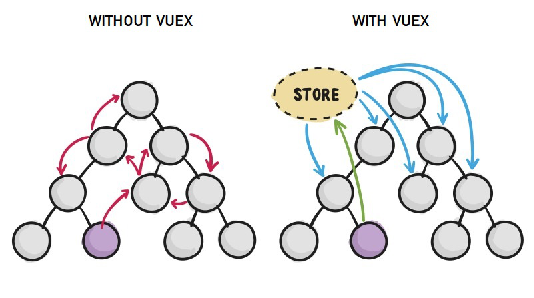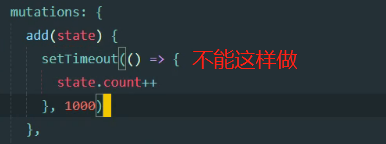一. Vuex 概述
1.1 组件之间共享数据的方式

由于使用频繁,通常将v-bind:属性名=" "的格式简写成:属性名=" ".兄弟组件之间的共享即不相干组件之间的数据共享。
子组件:
//子组件接受数据
props: ['nodeName'],
// 子组件触发listenToAuditor事件并传值
confirmAuditors(){
this.$emit('listenToAuditor',this.auditorIds)
this.resetAuditors();
this.dialogFormVisible=false
},
父组件:
<auditor-edit ref="auditor-edit" v-on:listenToAuditor="getAuditors" v-bind:nodeName="dataObj.nodeName"/> getAuditors(data){ this.auditors = data; console.log(this.auditors); const uploadObj = document.getElementById("uploadButton"); console.log(uploadObj) uploadObj.click(); },
上面这三种共享数据的方式,只适合在小范围内来进行数据的共享,如果需要频繁的或者大范围的来实现数据的共享,那么上面三种方案就显得力不从心了,下面来介绍Vuex.
1.2 Vuex 是什么
Vuex 是实现组件全局状态(数据)管理的一种机制,可以方便的实现组件之间数据的共享。

1.3 使用 Vuex 统一管理状态的好处

1.4 什么样的数据适合存储到 Vuex 中
一般情况下,只有组件之间共享的数据,才有必要存储到 vuex 中;对于组件中的私有数据,依旧存储在组件自身的 data 中即可。
二. Vuex 的基本使用
1. 安装 vuex 依赖包
npm install vuex --save
2. 导入 vuex 包,并安装到vue项目中
import Vuex from 'vuex' Vue.use(Vuex)
创建项目时用2.0版本,3.0版本的代码与这里的不同
3. 创建 store 对象,并且暴露出去
const store = new Vuex.Store({ // state 中存放的就是全局共享的数据 state: { count: 0 } })
4. 将 store 对象挂载到 vue 实例中,这样,所有的组件,就可以直接从 store 中获取全局的数据了
new Vue({ el: '#app', render: h => h(app), router, // 将创建的共享数据对象,挂载到 Vue 实例中 // 所有的组件,就可以直接从 store 中获取全局的数据了 store })
三. Vuex 的核心概念
3.1 核心概念概述
Vuex 中的主要核心概念如下:

3.2 State
State 提供唯一的公共数据源,所有全局共享的数据都要统一放到 Store 的 State 中进行存储。
// 创建store数据源,提供唯一公共数据 const store = new Vuex.Store({ state: { count: 0 } })
组件访问 State 中数据的第一种方式:
this.$store.state.全局数据名称
注意:在template标签范围内不需要this,直接写:$store.state.全局数据名称
组件访问 State 中数据的第二种方式:
// 1. 从 vuex 中按需导入 mapState 函数 import { mapState } from 'vuex'
通过刚才导入的 mapState 函数,将当前组件需要的全局数据,映射为当前组件的 computed 计算属性,这样在使用全局数据的时候,就像在用计算属性一样简单。
// 2. 将全局数据,映射为当前组件的计算属性 computed: { ...mapState(['count']) }
在实际开发中,具体使用哪一种方式,按需求定,哪个方便就用哪个
3.3 Mutation
Mutation 用于变更 Store中 的数据。(注意:不能使用this$store.state.count++,因为在vuex中不允许组件直接去修改store中的数据),只有mutations中的函数才有权利修改state中的数据

// 定义 Mutation const store = new Vuex.Store({ state: { count: 0 }, mutations: { add(state) { // 变更状态 state.count++ } } })
// 触发mutation methods: { handle1() { // 触发 mutations 的第一种方式 this.$store.commit('add') } }
计数器案例:
store/index.js代码
import Vue from 'vue' import Vuex from 'vuex' Vue.use(Vuex) export default new Vuex.Store({ state: { count: 0 }, mutations: { add(state){ state.count++ }, substract(state){ state.count-- } }, actions: { }, modules: { } })
父组件代码:
<template>
<div>
<my-add></my-add>
<p>---------------------</p>
<my-substract></my-substract>
</div>
</template>
<script>
import Add from './components/add'
import Substract from './components/substract'
export default {
name: 'App',
data () {
return {}
},
components: {
'my-add': Add,
'my-substract': Substract
},
created () {},
// mounted () {},
computed: {},
watch: {},
methods: {}
}
</script>
<style lang='less' scoped>
</style>
子组件代码
<template>
<div>
<h3>当前最新的count值为:{{ $store.state.count }}</h3>
<button @click="handle1">+1</button>
</div>
</template>
<script>
import {mapState} from 'vuex'
export default {
name: '',
data () {
return {}
},
created () {},
// mounted () {},
computed: {
...mapState(['count'])
},
watch: {},
methods: {
handle1(){
this.$store.commit('add')
}
}
}
</script>
<style lang="less" scoped>
</style>
可以在触发 mutations 时传递参数:
// 定义Mutation const store = new Vuex.Store({ state: { count: 0 }, mutations: { addN(state, step) { // 变更状态 state.count += step } } })
// 触发mutation methods: { handle2() { // 在调用 commit 函数, // 触发 mutations 时携带参数 this.$store.commit('addN', 3) } }
this.$store.commit() 是触发 mutations 的第一种方式,触发 mutations 的第二种方式:
// 1. 从 vuex 中按需导入 mapMutations 函数 import { mapMutations } from 'vuex'
通过刚才导入的 mapMutations 函数,将需要的 mutations 函数,映射为当前组件的 methods 方法:
// 2. 将指定的 mutations 函数,映射为当前组件的 methods 函数 methods: { ...mapMutations(['add', 'addN']) }
注意:使用第二种方式触发mutations时,传递参数方法:this.substractN(3)
3.4 Action
Action 用于处理异步任务。
如果通过异步操作变更数据,必须通过 Action,而不能使用 Mutation,但是在 Action 中还是要通过触发Mutation 的方式间接变更数据。Actions中想要修改state中的数据,还是得通过commit去触发对应的mutations中的某个函数,dispatch方法的作用就是去触发Actions中的函数,commit方法的作用是触发mutations中的函数。可以认为context就是store实例对象。
// 定义 Action const store = new Vuex.Store({ // ...省略其他代码 mutations: { add(state) { state.count++ } }, actions: { addAsync(context) { setTimeout(() => { context.commit('add') }, 1000) } } })
// 触发 Action methods: { handle() { // 触发 actions 的第一种方式 this.$store.dispatch('addAsync') } }
触发 actions 异步任务时携带参数:
// 定义 Action const store = new Vuex.Store({ // ...省略其他代码 mutations: { addN(state, step) { state.count += step } }, actions: { addNAsync(context, step) { setTimeout(() => { context.commit('addN', step) }, 1000) } } })
// 触发 Action methods: { handle() { // 在调用 dispatch 函数, // 触发 actions 时携带参数 this.$store.dispatch('addNAsync', 5) } }
通过谷歌的vue调试工具,我们可以很方便的观察到vuex中存储数据的变化状态。
注意,要延时1s,不要在mutations的函数中使用setTimeout函数,因为这样的话,vue调试工具中的count值(count=0)与页面显示的count值(count=1)不会保持同步,即此时vue调试工具不能正常工作了。所以,在mutations的函数中不能写异步的代码,而setTimeout为异步函数,在Actions中执行异步操作

this.$store.dispatch() 是触发 actions 的第一种方式,触发 actions 的第二种方式:
// 1. 从 vuex 中按需导入 mapActions 函数 import { mapActions } from 'vuex'
通过刚才导入的 mapActions 函数,将需要的 actions 函数,映射为当前组件的 methods 方法:
// 2. 将指定的 actions 函数,映射为当前组件的 methods 函数 methods: { ...mapActions(['addASync', 'addNASync']) }
mapActions其实本质上是把全局的某个函数addAsync映射为自己的methods中的一个函数了,此时可以直接将addAsync作为事件处理函数
<template>
<div>
<h3>当前最新的count值为:{{ $store.state.count }}</h3>
<button @click="handle1">+1</button>
<!-- <button @click="handleN">+N</button> -->
<button @click="addNAsync(3)">+N</button>
</div>
</template>
<script>
import {mapState,mapActions } from 'vuex'
export default {
name: '',
data () {
return {}
},
created () {},
// mounted () {},
computed: {
...mapState(['count'])
},
watch: {},
methods: {
handle1(){
// this.$store.commit('add')
this.$store.dispatch('addAsync')
},
// handleN(){
// // this.$store.commit('addN',3)
// this.$store.dispatch('addNAsync',3)
// }
...mapActions(['addNAsync']),
// handleN(){
// this.addNAsync(3)
// }
}
}
</script>
<style lang="less" scoped>
</style>
3.5 Getter
Getter 用于对 Store 中的数据进行加工处理形成新的数据。getters不会修改state中的原数据,它只起到一个包装数据的作用,将store中的数据变一种形式给返回出来,

// 定义 Getter const store = new Vuex.Store({ state: { count: 0 }, getters: { showNum: state => { return '当前最新的数量是【'+ state.count +'】' } } })
通过count的值对外包装一个新的数据叫做showNum,这是我们可以将showNum定义为一个函数,第一个参数就是state对象,我们只要调了showNum这个函数,就会返回一个新的数据,即返回一个字符串“当前最新的数量是【'+ state.count +'】”
使用 getters 的第一种方式:
this.$store.getters.名称
<template>
<div>
<h3>{{$store.getters.showNum}}</h3>
</div>
</template>
export default new Vuex.Store({ state: { count: 0 }, getters: { showNum: state=>{ return '当前最新的数量是【'+state.count+'】' } } })
使用 getters 的第二种方式:在computed计算属性中,调用mapGetters,从而映射出当前组件中的计算属性。
import { mapGetters } from 'vuex'
computed: {
...mapGetters(['showNum'])
}
<template>
<div>
<h3>{{showNum}}</h3>
</div>
</template>
<script>
import { mapGetters } from 'vuex'
export default {
name: '',
data () {
return {}
},
computed: {
...mapGetters(['showNum'])
}
}
</script>
3.6、Modules
module:可以让每一个模块拥有自己的state、mutation、action、getters,使得结构非常清晰,方便管理。
const moduleA = { state: { ... }, mutations: { ... }, actions: { ... }, getters: { ... } } const moduleB = { state: { ... }, mutations: { ... }, actions: { ... } } const store = new Vuex.Store({ modules: { a: moduleA, b: moduleB})
<template> <div id="app"> <h1>{{useName}}</h1> </div> </template> <script> export default { // computed属性,从store 中获取状态state,不要忘记login命名空间。 computed: { useName: function() { return this.$store.state.login.useName } } } </script>